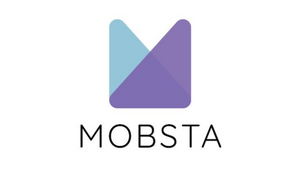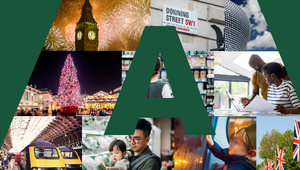
The Reality of OOH Today: ‘The Complete Marketing Tool for Brands’

Mobsta is a proud supporter of LBB. As part of its sponsorship of the ‘Brand Insight’ and 'Media' channels, we’re exploring audience and media trends, discovering what brands and media experts think makes audiences tick in 2023 and beyond.
Nicole Lonsdale is chief client officer at Kinetic WW, where she has worked since 2007. In that time she’s held the positions of client service director, head of activation and client development for the UK and chief planning officer, before taking up her current role in 2020.
In this interview, Nicole gives her perspective on the state of play for out-of-home media today, from its programmatic, data-driven applications to the changes that need to be made for clients and media agencies to take sustainability goals seriously.
LBB> When did you first start finding media interesting? And what aspect has kept you interested?
Nicole> I initially fell into media when I was offered a role at Posterscope a month after graduating from university with a degree in history. At the time I would never have imagined that my career would progress in media, but what’s kept me in it is the pace, variety and how you need to be at the forefront of changes and trends in society. It continues to be an exciting and rewarding industry for those at school, college or university who are just stepping out into their careers. Very few sectors can offer the breadth of clients and categories that you have the chance to work with, the scope for creativity and the different people you get to meet.
LBB> You've been at Kinetic for 16 years now. What first drew you to the agency and what's kept you there?
Nicole> I’m very proud to be part of Kinetic and to have played a role in shaping the business we have today. We strive to lead the market, not just in terms of revenue but in the way we operate as a business with our people, the OOH campaigns we produce, the way we work with our clients and with our communications and thought leadership.
People are the heart of our business and we have built an inclusive culture that embraces difference. We want our people to be the best versions of themselves and we have a strong focus on learning and development and celebrating success.
Our aim is to shape the future of OOH whether that’s leading the market with programmatic and data, our award-winning creative solutions, and our positioning of OOH in a digital world.
LBB> Out of home is the focus of the agency. Why is it such an exciting media channel to you?
Nicole> I love working in OOH. It’s the oldest media channel but one that is constantly evolving.
Over the past five years the industry has changed beyond recognition. Huge levels of investment into the digitisation of inventory, new data sets, and innovative technology to automate processes means the legacy perception of OOH as just a broadcast channel is fundamentally outdated.
While OOH continues to deliver more reach than any other commercial channel (which makes it the most inclusive brand-building channel), its capabilities are far broader. The ability to integrate smart data and activate dynamically in near real time means OOH can now offer lower funnel benefits to influence and drive immediate action or purchase. And the rise of mobile commerce outside of the home means that OOH can not only drive consumers into physical stores but also online.
OOH is also the most creative media channel. The opportunities to stand out are immense – from simple special builds and murals to experiential opportunities, 3D content, and interactive activations where mobile devices can connect with screens to deliver richer content or drive commerce. At Kinetic we’ve seen huge growth in innovative OOH solutions, which consumers can experience in the real world or view online where campaigns can be amplified via social media.
OOH really is the complete marketing tool for brands.
LBB> What are the biggest focuses for you in your role at Kinetic today?
Nicole> My biggest focus is on educating brands on the capabilities OOH now offers, demonstrating the effectiveness of the channel and ultimately growing OOH’s share. OOH currently accounts for 4.5% of total advertising expenditure but should command a much higher share. OOH should feature on many more media plans than it currently does.
While many advertisers appreciate the role OOH plays in driving brand fame, there is more education needed to highlight its lower-funnel capabilities. Whether that’s dynamically changing creative in real time based upon weather, sales, or sentiment, to activating trading programmatically and integrating DOOH into a wider digital media plan.
In my role I oversee planning, marketing, insight and creative solutions. I work closely with each head of department to ensure we are delivering on this through our campaign solutions, the research we produce and the messages we communicate to market.
LBB> The carbon footprint of different media is an interesting topic of debate at the moment. What needs to change in order for clients to be buying media with sustainability in mind? As opposed to paying lip service and then making decisions purely based on business objectives?
Nicole> Media agencies are quite rightly focusing more on the sustainability aspect of campaigns. The majority are now using carbon calculators to understand and report emissions, but we’re all still at the very early stages. From an OOH perspective, carbon calculators need to factor in the fact that the channel is one to many, and lots of the environmental aspects of the channel can’t be reported by them.
For example, just under 50% of OOH revenues go back to community and environmental projects and initiatives. Whether that’s helping those from disadvantaged backgrounds, regreening urban spaces, funding public transport and financing public infrastructure such as street lighting or free wifi.
There is a huge education piece needed to provide brands with the most accurate information on each channel. If we take DOOH screens as an example, most screens are powered by renewable green energy, yet many clients are not aware of this. More could also be done to demonstrate how brands can use media channels to influence environmental behavioural change – whether that’s including messaging about recycling empty products or switching to greener options.
Thinking more to the future – to gain the most traction, the effectiveness of media must also be overlayed into carbon calculators, so media plans are balancing emissions with ROI.
Advertising exists to change behaviours and drive sales and the most carbon effective media plan must consider both.
LBB> When it comes to targeting their media at the right audiences, what are the questions that your clients are most keen to have answered?
Nicole> Probably how we can demonstrate that a campaign has delivered on reaching a particular target audience in a GDPR-compliant way and achieved the desired outcomes.
While OOH is one of the last remaining broadcast channels, with smarter data and tech we have a better understanding of audience behaviour outside of the home (i.e. how and where people are travelling to for work, shopping or leisure), how we can optimise campaigns to best reach them and how the campaign has delivered on specific outcomes.
At Kinetic we invested in a new behavioural planning platform called Journeys in January 2020. Journeys houses a range of online and offline data to allow us to understand consumer behaviour in near real time. This allows us to select the most effective formats, environments and frames that index the highest against a particular audience by location and time.
Journeys powers both our traditional and programmatic campaigns and is also used to measure outcomes. Through the data in the platform, we can identify those that have been exposed to a campaign and whether they’ve then taken an action (i.e. gone into store, gone online). We can also measure brand uplift too.
Journeys is GDPR compliant and uses anonymised and aggregated data, but it's refreshed daily which means we have almost live information that can inform and shape our campaigns.
LBB> Data laws have been evolving for some time in a way which means more limitations on the data available to businesses. How does Kinetic's role as an out-of-home agency intersect with that trend?
Nicole> While other channels have and will be hit by changes in privacy laws and the demise of the cookie, OOH has never relied on Personal Identifiable Data (PID).
At Kinetic we developed our Journeys platform in January 2020 which houses a range of online and offline data sets. Data has allowed us to become smarter and more effective with our media planning and allowed campaigns to be more integrated with other channels; particularly digital.
Through the data we have a better understanding of consumer behaviour outdoors – where people travel to, modes of transport used, how and where people shop and spend their leisure time. We understand how this is different according to location/geography but also time of day and day of week.
Journeys can be used to optimise campaigns, both in terms of placement (frame selection) and creative messaging, and it can also measure outcomes.
LBB> What’s the trend in media strategy circles that you’re getting tired of hearing about and why?
Nicole> AI is perhaps the latest buzzword in media. While I’m not at the stage where I’m tired of hearing about it (as it's only starting to gain traction in advertising) it’s definitely being overused and overclaimed in some ways.
There is lots of scope for AI to assist with messaging and content in advertising and Meta and Amazon have both claimed that it will be core to their businesses.
Even for OOH, there is opportunity for AI powered dynamic content. Dynamic creative optimisation (DCO) in OOH has become more mainstream and countless research studies have demonstrated how contextual messaging drives greater outcomes.
It’s possible to deliver multiple copy/message changes throughout the day depending upon a range of variables such as location, time, sales, weather, events etc. AI should supercharge this, creating the ability for OOH, with the highest audience reach, to deliver national campaigns with even more localised and contextual content.












